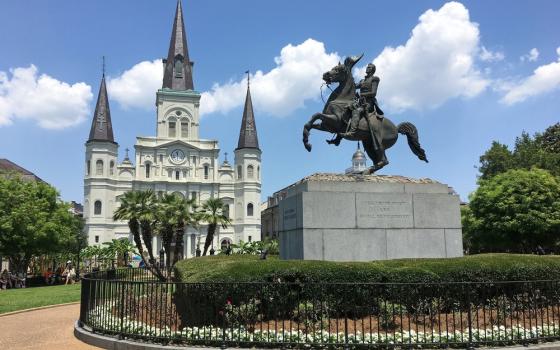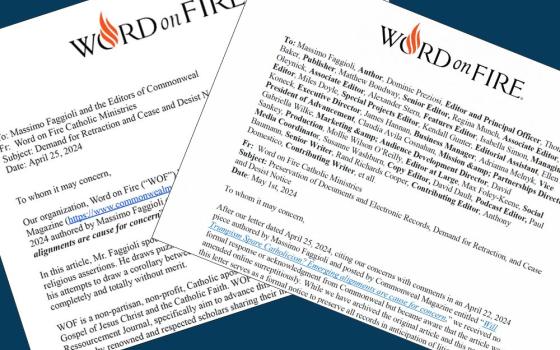
Parish Life
Throughout the last century the tall spires of U.S. Catholic churches could be seen rising above city neighborhoods or as the highest point below the grain elevator in a small town. Those spires symbolized the values, spirituality and community to be found in the parish church, school and gathered assembly.
Today some feel Catholic parishes could become seedbeds for a wider embrace of earth-friendly practices, and they are making it happen.
In their 1995 pastoral, “At Home in the Web of Life,” the Catholic bishops of the Appalachia region asked: “Now might not our own Christian communities themselves become small centers of a sustainable path, small islands of creativity, proclaimers of a culture of life?”
Susan Hedge, ecology educator for the Richmond, Va., diocese, said that statement was the germ out of which her full-time position grew.
On the diocese’s Web site, a section on green parishes offers guidelines for those who want to increase ecological awareness and take earth-friendly steps.
Hedge told NCR: “Usually one or two people in a parish want to do something. We advise them not to jump into it, but to start a process of education and reflection.
“There are often so many volunteer groups within a parish doing useful things -- a social justice group or a bereavement group. You can’t go in and tell them what to do, tell them they have to serve fair trade coffee.
“We recommend three steps, based on what we call the A-R-T process. First to act. A creation-care group can measure the parish’s current commitment using our ecology checklist for parishes found on the Web site. Then we ask them to reflect. The process must be centered in prayer and reflection. Then the group uses the findings to make a plan of action for transforming the parish through structural, worship and educational actions.”
The “Ecology Checklist for Parishes,” which is used to measure their care for creation, lists about 30 items that can be checked off to determine the level of commitment. These include:
- “A blessing of animals is held annually.”
- “Earth-keeping confessions, intercessory prayers, hymns, and sermons are incorporated into weekly worship throughout the year.”
- “Creation care is featured in the weekly bulletins.”
- “Reusable cups and dishes are used at parish gatherings.”
- “Members are notified with periodic action alerts about local, regional and national environmental issues.”
Some U.S. parishes are far down the path to becoming green.
Thanks to the efforts of its pastor, Fr. Charles Morris, St. Elizabeth Parish in Detroit stands out. It’s a working-class congregation located in an inner-ring suburb of probably the last city in the country one would expect to produce a green parish.
“In 1988 I heard climate scientist James Hansen speak,” Morris told NCR. “It was a warning shot across the bow. Then I read Fr. Tom Berry’s book Dream of the Earth and heard him speak. My mantra became: ‘We are part of creation, not apart from creation.’ It occurred to me early that if it doesn’t come from churches, I don’t know where it will come from.”
 In 1997 his parish had an energy audit done by the Environmental Protection Agency. They started a community garden. Between 1997 and 2002 there was a 60 percent reduction in the parish’s energy demand. This was accomplished by a wide variety of steps.
In 1997 his parish had an energy audit done by the Environmental Protection Agency. They started a community garden. Between 1997 and 2002 there was a 60 percent reduction in the parish’s energy demand. This was accomplished by a wide variety of steps.
New windows were installed in the church, along with a more efficient boiler in the church basement. Double-paneled windows created an envelope system with dead air between the two panes.
All the incandescent light bulbs in church and rectory were changed to compact fluorescent bulbs. Simple things like weather-stripping on doors and programmable thermostats in the church and rectory were introduced. The boiler pressure was lowered from 8 pounds to 2.5.
On the water side, low-flush toilets and low-flow showerheads were installed, and rain barrels added to supply the garden. A solar attic fan was installed in the rectory. The sun hits a small photovoltaic panel located on the roof that powers the large fan.
On the roof of the rectory garage, 64 square feet of solar collectors provide for hot water needs, supplying 100 percent of the hot water in summer. The rectory’s front porch roof has four 120-watt solar panels. Sixteen batteries in the basement store the power generated by the solar panels, and that power runs seven circuits in the rectory building.
“I woke one morning last winter,” Morris said, “and found out later there had been power outage in the neighborhood from an ice storm. I didn’t even know it.”
The rectory and church lawns are managed without pesticides or chemicals.
In the back of the church there is a farmers’ market after Sunday Mass, where local farmers sell their produce. One farmer regularly sells raw milk and honey.
In addition, the parish has sponsored classes for the parishioners and neighbors in sustainable living -- teaching canning, root-cellaring, and the use of non-toxic household cleaners.
Recently the parish sponsored a picnic and ice cream social. “We ate free-range chicken and pork chops, and I made homemade ice cream using raw cream, with no hormones or antibiotics,” Morris said.
He tries to use the liturgical year as occasions for preaching. “I talked about the food system on Corpus Christi Sunday, and used a cosmological theme on Trinity Sunday.”
 The parish council likes the fact that the parish saves “a ton of money,” Morris said.
The parish council likes the fact that the parish saves “a ton of money,” Morris said.
“On Trinity Sunday of 2001 we dedicated the new solar panels after Mass. I used a prayer for blessing of solar panels that I got from a member of Michigan Interfaith Power and Light.
“Up on the roof with my stole and holy water on a clear day there was not a breath of wind, but then as the holy water hit the turbine a gust of wind came from nowhere. I was reminded of the upper room with its tongues of fire and mighty wind.”
The National Catholic Rural Life Conference, headquartered in Des Moines, Iowa, has taken the lead in networking green parishes together and promoting them.
For years their Web site featured a list of religious communities around the country that had initiated and continued some kind of sustainable earth-friendly practice, whether it be providing space at their motherhouse for community gardens, starting an organic farm, or retrofitting buildings with earth-friendly building materials.
Over 130 were listed there, mostly women’s communities.
Tim Kautza, environmental specialist for the conference, has begun compiling a database of parishes that are involved in similar efforts, along with one for Catholic hospitals and health care facilities and one for colleges and universities. The conference is actively seeking parishes to list on this searchable database.
“In many cases with parishes, it begins with the school buildings,” Kautza said. “They are retrofitted in some way to improve energy efficiency, then the parish follows suit. If there are one or two really committed people then it can really take off and go much further.”
Kautza cited just a few examples of parishes around the country that have turned green:
- All Saints Parish in Brookline, Mass., replaced their 30-year-old steam boiler with a high-efficiency gas-fired hot water boiler and nine-zoned heating system with each zone having its own in-space programmable thermostat and a central digital controller. Their effort prevents nearly 79,000 pounds of carbon dioxide pollution per year.
- Presentation Parish in Stockton, Calif., distributed 2,000 compact fluorescent bulbs to parishioners, promotes biking and walking to Mass on Sundays, and actively campaigned for passage of a 2006 bill that mandated statewide reductions in greenhouse gases.
- St. Matthias Parish in Redwood City, Calif., recycles paper, bottles and cans and household batteries in the parish hall. It conducts fair trade/organics fairs and encourages local stores to carry organic and fair trade food products. The parish will soon hold a 100-Mile Potluck, a picnic that will challenge parishioners to prepare foods for which the ingredients come from within 100 miles from home, thus reducing the carbon footprint of food purchases.
Rich Heffern is an NCR staff writer. His e-mail address is rheffern@ncronline.org.






